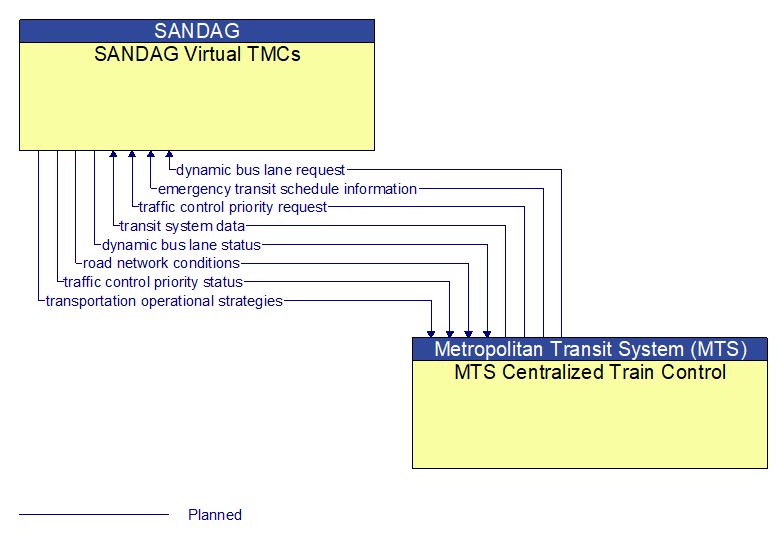Interface: SANDAG Virtual TMCs - MTS Centralized Train Control

Information Flow Definitions
dynamic bus lane request (Planned)
Request for a restricted bus lane. May also describe affected services and include schedules with specific vehicle arrival times.
dynamic bus lane status (Planned)
Status of dynamic lane request, identifying if the request can be met, and the specific lane, start, end location, and time period where priority or exclusive access is to be granted.
emergency transit schedule information (Planned)
Information on transit schedule and service changes that adapt the service to better meet needs of responders and the general public in an emergency situation, including special service schedules supporting evacuation.
road network conditions (Planned)
Current and forecasted traffic information, road and weather conditions, and other road network status. Either raw data, processed data, or some combination of both may be provided by this flow. Information on diversions and alternate routes, closures, and special traffic restrictions (lane/shoulder use, weight restrictions, width restrictions, HOV requirements) in effect is included.
traffic control priority request (Planned)
Request for signal priority at one or more intersections along a particular route.
traffic control priority status (Planned)
Status of signal priority request functions at the roadside (e.g., enabled or disabled).
transit system data (Planned)
Current transit system operations information indicating current transit routes and fares, the level of service on each route, and the progress of individual vehicles along their routes for use in forecasting demand and estimating current transportation network performance.
transportation operational strategies (Planned)
Operational strategies for each operating agency in a transportation corridor, downtown area, or other travel–impacted area, providing an integrated operations strategy for the freeways, tollways, arterials, transit services, parking facilities, and other transportation–related facilities in the area. These strategies can include dynamic adjustments to transit fares and tolls, parking fees and restrictions, dynamic lane restriction changes, and other active demand management strategies.